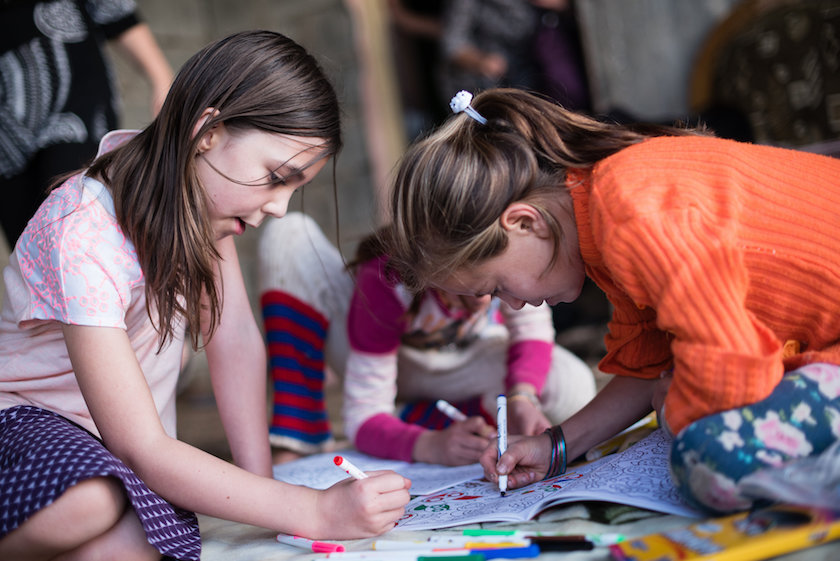Hurricane Harvey has dropped 51.88 inches of rain—that’s 4 ¼ feet of rain—on Cedar Bayou, Texas, just east of the metro Houston area. In our shock, we say things like “unimaginable!” Except that we can imagine it perfectly well—we’ve all seen the stunning images of rivers where roads used to be. Over the last couple days, members of our response team have seen it with their own eyes.
We’re wired to be helpers. In the face of disaster and feelings of helplessness, we crave something to do, some way to help families in need with our energy and resources. In the coming days, there will be many ways to help families most impacted by the storm in southeast Texas, but you don’t have to wait.
Here are some practices we use regularly in Iraq, adapted for the US.

4 things you can do today if you’re stranded in a shelter:
- Connect. Be present for those around you. Strike up a conversation with the person on a nearby cot. Ask about their life, neighborhood and home. Listen to their stories, and share some of your own. Even in a crowded shelter, it’s easy to feel alone. If your phone is still charged and you have connectivity, share news local news and updates with others in the shelter who may not be connected.
- Distract. Help keep the children busy. Gather some kids together in the main space and tell stories or play games. Not only will it help ward off boredom, but many of the children in the shelter will be processing their own fear and stress (even if they don’t talk about it). Keeping them busy will give them the chance to forget their angst for a little while.
- Rest. Find ways to provide little breaks for each other. Take turns with other parents entertaining the kids. Even just a few minutes of quiet and rest can make the difference between coping in the shelter or not.
- Learn. Your neighbors in the shelter might have done this before—they might be former New Orleans residents who already fled one disaster. Or perhaps there are elderly residents who survived natural disasters no one remembers anymore. Ask what helped them through. Learn from their experience.

4 things you can do today if live near a shelter:

If you live in southeast Texas, sites like this one can help you find where the shelters in your area are located. Call ahead to see if there are needs you can meet. Plan to visit the shelter and help as you are able.
- Show up. You don’t have to help the entire shelter. Spend a little time meeting families, and find someone who could use your support. Help to create a little bit of calm for them. Be present. Listen to stories, fears, complaints—whatever they need to get off their chest. Bring extra phone and computer chargers and power banks so folks can charge their devices. Share your phone or data, or turn on your internet hotspot so those unable to make essential calls can do so. Help your neighbors find important numbers they will need but might not have handy, like FEMA or their insurance agent.
- Distract. Children will appreciate all kinds of activities to help them deal with their trauma, restlessness, exhaustion and boredom. Bring along coloring books and crayons—then color with the children. Bring craft supplies—sit with them and make crafts. Listen to their stories and concerns. Bring your charged laptop loaded with cartoons and movies to watch. Bring along nail polish and let the girls paint each other’s nails (and yours!). If you knit or crochet, bring along yarn, hooks, and needles. Busy hands can keep minds free to process trauma. Knit together… and listen. Teach a child who would like to learn. Swap stories with dads. Come ready with “dad jokes” and laughter. Reminisce about the neighborhood and their home.
- Help your sisters feel like themselves again. Shock and trauma take a toll, not to mention spending time on your roof waiting to be rescued! Simple things can help women in the shelter feel better about themselves—and feel a little more together and able to face the day ahead. If you have extra makeup and hand mirrors, bring them along. Ear plugs and eyeshades can be essential shelter items. Shelters are loud places, and since it’s policy in most shelters to keep the lights on at night for safety reasons, it can be impossible to sleep.
- Repeat. Before you leave the shelter, ask workers what they need. Share those needs with your community. Show up again with the needed items. Schedule time regularly over the weeks ahead to continue showing up for your neighbours.

4 things you can do today, no matter where you live:
- Donate. Many folks want to share extra blankets (clothes, etc.) with Texans, but what they need most are cash donations. This early in the crisis, local shelters don’t have the capacity to wade through donated goods to find useable items. And with so many southeast Texas businesses damaged by the hurricane, it’s essential to invest money into the local economy.
- Stay Informed. There has been a lot of media coverage about Hurricane Harvey, and the grim images and newsreels are starting to take their toll. Don’t tune out. Continue to be present. Listen for the needs.
- Prepare to help after the initial crisis is over. The disaster that has unfolded over the last few days won’t be fixed for a long time. When the flood subsides, and the media turns their lenses to other stories, there will still be thousands of hurting Texans. That’s when we’re needed most. That’s when we need to keep showing up.
- Help the second circle of connection. If you have friends or relatives with Texan roots who are trying to help from afar, ask what they need. Help them with childcare and meals so they are free to do what they can for their families and loved ones impacted by the crisis.
It’s easy to feel helpless in the face of tragedy. But wherever you are right now, there are many ways you can help. You were made for this. You’ve got this. Let’s show up for the people of Houston together.



